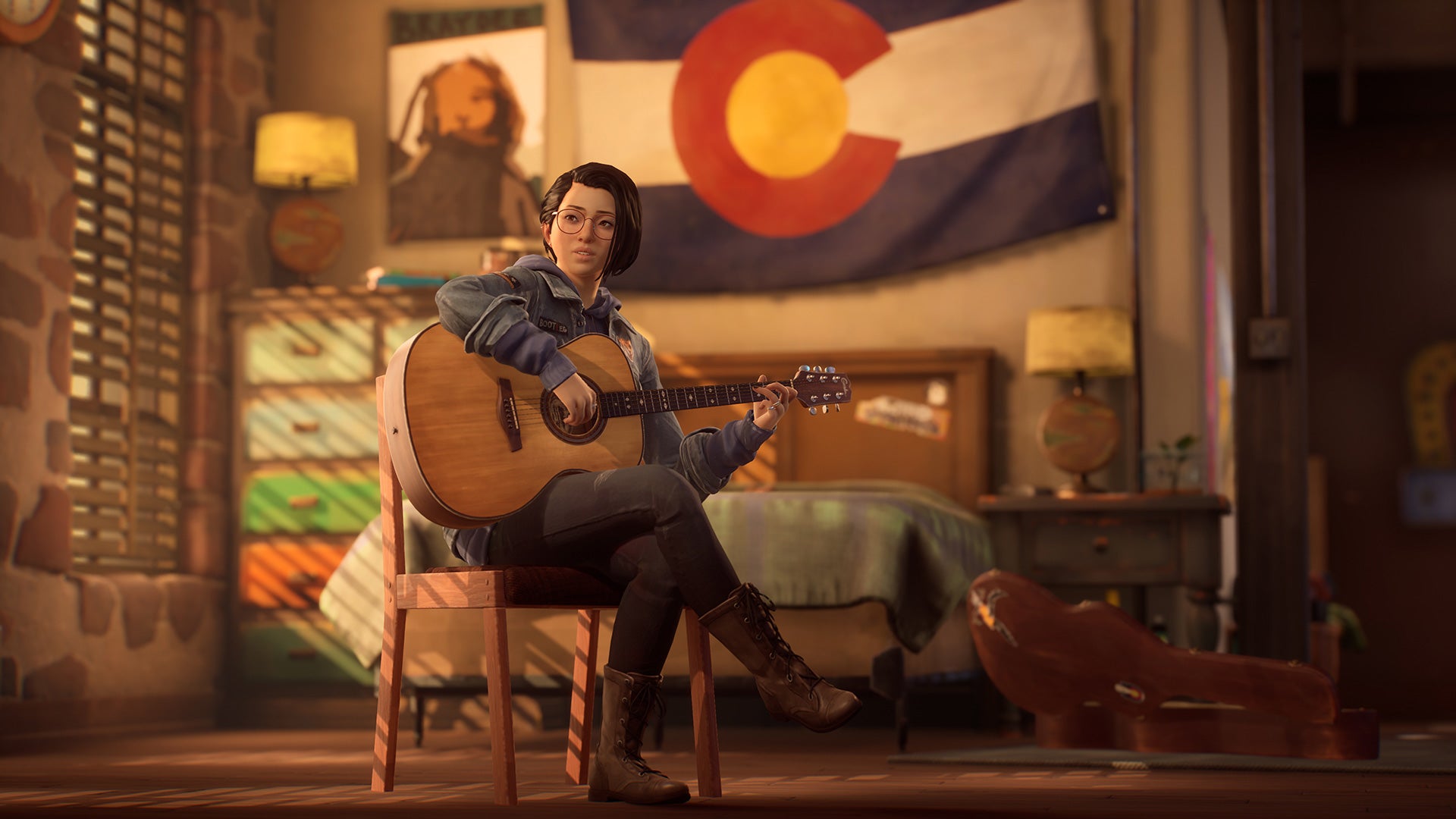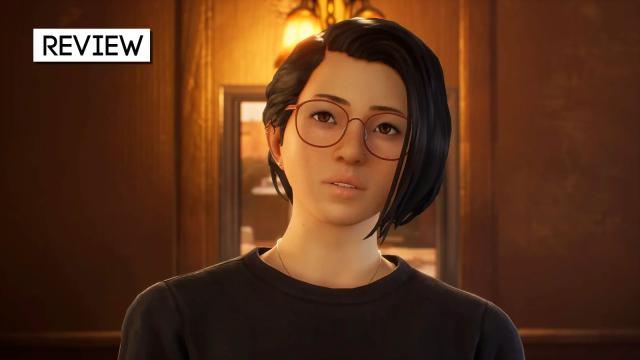If Life Is Strange: True Colors is meant to paint a picture of what’s to come from the supernatural franchise, then I am here for it.
True Colors shines in all the right ways for a Life Is Strange game. It provides a litany of characters that invite you to get to know them, a gripping story, and a unique protagonist with her own gameplay-defining powers, a signature of the franchise.
Life Is Strange: True Colors is the third mainline game in the series. This time, developer Deck Nine Games is at the helm. Deck Nine also made the well-received prequel Life Is Strange: Before the Storm. In a press release, Deck Nine describes True Colors as a new era. That era officially starts September 10, when the game comes out for PlayStation 4, PlayStation 5, Xbox One, Xbox Series X/S, Nintendo Switch, PC, and Google Stadia.
It’s also the first game that will release all five episodes at once. All earlier games had their chapters come out months apart, similar to Telltale’s narrative adventure games. The True Colors experience, therefore, feels like a binge more akin to devouring an entire season of a Netflix show whole rather than waiting in real time for cliffhangers to be resolved. But True Colors is short and can be easily finished in under 10 hours. I also find that playing straight through makes the plot much easier to follow and remember.
We meet Alex Chen, who is a protagonist unlike any other in the series, as she arrives in the small Colorado town of Haven Springs to live with her estranged older brother. She’s an adult who’s already aware of her powers. And compared to her predecessors, who were sent on psychological roller-coaster rides as they struggled to come to terms with their newfound abilities, Alex feels more measured for it. It takes a lot to throw Alex as she’s already seen quite a bit before. And she’s less likely to react recklessly than the teenage protagonists the franchise has previously offered up. It’s a fresh perspective that manages not to take away from the coming-of-age narrative that Life Is Strange is known for. After all, 21 is a time ripe with transformation.
Further, Alex is actually likable. It’s easy to want to root for her, and the game provides entry points early on to learn about Alex’s history. Much like the journal and sketchbook systems of Life Is Strange and Life Is Strange 2, we can see a bit of where Alex has been through her texts and limited journal entries. We learn that she grew up in the foster care system and has been separated from her brother for several years. The game doesn’t hit us over the head with Alex’s tragic backstory in a lazy attempt to draw sympathy for its main character, but it also doesn’t ignore that crucial history.
And for her requisite Life Is Strange superpower, Alex Chen has: empathy? I’ll admit, I wasn’t entirely sold on this “power” when it was first revealed, though I was intrigued by the game as a whole. True Colors quickly made my fears dissipate, however. The stakes feel lower than those introduced by previous protagonists’ abilities, as the life-or-death implications aren’t so obvious. And most cases in which Alex might use her power are far more mundane than the situations you find yourself in during the first two games. There’s still drama and tension to make your choices feel impactful, but everything feels more grounded.
Much of your power is used to simply learn more about those around you. The effect is powerful as the world changes when you, quite literally, put yourself in someone else’s shoes. Admittedly, this feels quite invasive. Most people aren’t even aware you have this ability, let alone give you permission to enter their psyche. You don’t just feel what another person feels. Instead, you sense what they’re thinking. You walk into others’ memories uninvited. Alex grapples with what responsibility she has to others and how best to use her power. But we never quite see the culmination of this thought process.
Overall, True Colors does a good job of not making this feel like a cheap tool of exposition as you only get snippets of information that Alex then interrogates further by speaking with the other person. Had she relied on just her abilities rather than getting the full story through honest conversation, True Colors and its story would feel voyeuristic and disappointing. Alex’s empathy can still be a tool of manipulation, though, something that the game and its protagonist sometimes falter at balancing before ultimately pulling through.
The risk of using such powers to manipulate others is a dynamic that Max explores in the first Life Is Strange, but Alex is more experienced than high school student Max was. She’s also a hell of a lot better at talking to people and not tripping over handling her power in conversation.
The bigger conversation godsend in True Colours, however, is by far the dialogue. The writing is, ahem, hella good.
Fans of the other games, especially the first entry, will remember the painful dialogue. It was translated from French, which certainly added a layer of difficulty, and the result was quite messy. Life Is Strange has become intertwined with its overuse and misuse of slang, earnest-to-the-point-of-cringe declarations and overall missteps in capturing the rhythms of how people actually talk to each other.
Thankfully, True Colours puts that history to bed. In fact, the dialogue is an absolute bright spot. Each character has a personality and the writing feels natural. Hell, there’s even well-executed comedic timing. The attention to writing throughout infuses the game with the authenticity and charm that its predecessors lacked.
This is extended to the “online” aspects of the game. As your story progresses, you can fill in the blanks by looking at your messages and the fictional social media site MyBlock. The online world feels amazingly realistic in a way that many games, even with top-notch writing, often stumble on.
But the best part of this is that the messages and posts aren’t simply relegated to filler. They flesh out each character and make them relatable. The older man who has entirely too many stories for any one person opens each text addressing you and signs off with his full name. That’s a thing that people do! There are ideological fights in the comments on MyBlock between the right and the left. Thankfully, this is limited as I could use some escapism from that part of online life. And accounts can disable comments if they start getting too much heat.
The people filling those comment sections and your inbox are easy to get to know. They draw you in like the cast of one of your favourite shows. A big part of True Colours is the idea of community. But rather than throwing you into a new town of NPCs and telling you this is a community, the game actually makes the world and people feel like one.
But Alex is new to town, and she doesn’t have a great history of finding homes where she belongs. In addition to the lack of stability that comes with being a foster kid, Alex has had to grow up with abilities she can’t control. From the small window we have into her past, it doesn’t look like it’s been easy.
So coming to Haven Springs to live with her older brother is jarring. Everyone feels so perfect. We quickly learn that each person isn’t quite so perfect, as no one is. But that doesn’t make Alex’s feelings as an outsider any less justifiable.

Seeing Alex sing Radiohead’s “Creep” in an early trailer felt like light teenage angst fodder upon first viewing. But having seen it in context, it’s heartbreaking.
It’s a joy to watch Alex eventually grow in this space. We see her make friends, hold down a job, and find new hobbies. This isn’t news to anyone who watched the game’s trailers, but Alex’s brother Gabe dies early on. In the face of loss, Alex finds a way to live a fulfilling life. Each entry in the Life Is Strange franchise deals with grief and loss in some way. But True Colours feels the most hopeful.
Beyond just tackling tough topics at the root of its plot, True Colours breaks into a nuanced depiction of grief that I don’t know if most other games would touch. I won’t spoil any of the most impactful scenes here, but True Colours handles the facets of loss with delicate agility. It asks who’s to blame for loss, whether that’s ourselves, the very person we’re grieving, or even the ones we hold closest. None of those answers are easy, but some are harder to face than others. While Alex is our protagonist, we experience Gabe’s loss from all angles as we continue the story surrounded by his friends and the family he’s made in Haven Springs.
The first Life Is Strange gives us many NPCs to learn about, but they feel flat in comparison to Max and Chloe, our main characters. The second in line gives us fewer opportunities to engage with others in a meaningful way. But True Colours lets the residents of Haven Springs come into their own.
When I say the story of True Colours is more character-driven than its predecessors, you might look at me sideways for a bit. Yes, each game has a splitting narrative that changes based on your decisions, most of which involve another person. But those choices still feel a bit random at times. The game seems to take more pleasure in flipping what we think is the “right” choice. What feels satisfying in the moment might bring regret later. The first title especially leans heavily into the Butterfly Effect.
True Colours, however, changes its story based on more organic relationship growth. Certain options or outcomes are locked, in a way, depending on whether you’ve grown close enough to the other person. This makes it feel less like a system of, “If I do x, then y,” and more like the possibilities and options we face in real life. Had I taken that colleague up on their offer to get coffee or stayed in touch, I could call them now for a favour, for example.
That characterization is extended to your two love interests, Steph and Ryan. There’s a moment when you can say whether you’re interested in men, women, or anyone. I said anyone, as that’s true for myself (and I like to not limit myself in games), but I haven’t gotten a chance to replay and see if both people are viable romantic options should you choose one gender or the other.
But both felt equally charming to me, causing some bisexual panic to ensue. What I love about this side plot, though, is the slow burn. “Choosing” one person, or choosing whether to pursue any romantic prospect at all, isn’t determined entirely by one choice. Yes, there is a make-or-break moment, but True Colours lets you explore both options in-game, making the payoff that much sweeter. And the payoff isn’t entirely relegated to a post-game happily ever after. These relationships can also affect where the game takes you.
Still, Haven Springs is more than just the people who inhabit it. The world is absolutely beautiful as it captures the mountains of Colorado, and the semi-open structure makes it a delight to explore. The game has the same look-around-for-a-collectible mechanic as previous entries, this time in memories attached to inanimate objects. Searching for these collectibles feels like more than just trophy hunting as it reveals new information and memories to better fill out the stories’ of the characters around you. And since the space is larger than most of the scenes or chapters you’re limited to in the other Life Is Strange games, exploring and interacting with everything possible is a bigger challenge.

During much of the game, you’re able to roam around Main Street, engage with minor NPCs and make small changes for the better of those around you. It feels sweet and cosy, fitting for the type of small town cool enough to have its own dispensary and indie station broadcast from a record store. The small details tell a story about Haven Springs as its own entity, similar to the found objects in Fallout or The Last of Us.
The game encourages you to explore everything and hints at stories being told in the objects around town. Even without Alex’s powers, there is a history woven into the neighbourhood if you let yourself take the time to find it.
Much of it will feel unrelated to the story True Colors is telling, and some of it is. But I was stunned at how deftly the plot wove together threads that felt like they didn’t belong together at all. The payoff for exploration goes beyond cute easter eggs or asides. It truly completes the story you’re playing. And picking out clues dropped early on is extremely satisfying. In one instance, I noticed a couple’s initials carved into a stool at the local bar. What seems like some nice colour added to the backdrop of the town much later turns out to be remnants of a love story I would have to work to unravel. That’s to say nothing of the plot-related clues I hit myself over the head for not connecting earlier once the story revealed itself.
There’s a great deal of pain explored in True Colors, but there’s just as much optimism — maybe even more so — and so much fun.
Deck Nine got a chance to prove itself with Life Is Strange: Before the Storm, but if there were any lingering doubts about where the developer can take the franchise, they’re surely cleared away with True Colors.

Leave a Reply